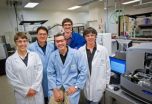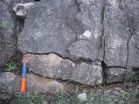(Press-News.org) Teaching a robot a new trick is a challenge. You can't reward it with treats and it doesn't respond to approval or disappointment in your voice. For researchers in the biological sciences, however, the future training of robots has been made much easier thanks to a new program called "PaR-PaR."
Nathan Hillson, a biochemist at the U.S. Department of Energy (DOE)'s Joint BioEnergy Institute (JBEI), led the development of PaR-PaR, which stands for Programming a Robot. PaR-PaR is a simple high-level, biology-friendly, robot-programming language that allows researchers to make better use of liquid-handling robots and thereby make possible experiments that otherwise might not have been considered.
"The syntax and compiler for PaR-PaR are based on computer science principles and a deep understanding of biological workflows," Hillson says. "After minimal training, a biologist should be able to independently write complicated protocols for a robot within an hour. With the adoption of PaR-PaR as a standard cross-platform language, hand-written or software-generated robotic protocols could easily be shared across laboratories."
Hillson, who directs JBEI's Synthetic Biology program and also holds an appointment with the Lawrence Berkeley National Laboratory (Berkeley Lab)'s Physical Biosciences Division, is the corresponding author of a paper describing PaR-PaR that appears in the American Chemical Society journal Synthetic Biology. The paper is titled "PaR-PaR Laboratory Automation Platform." Co-authors are Gregory Linshiz, Nina Stawski, Sean Poust, Changhao Bi and Jay Keasling.
Using robots to perform labor-intensive multi-step biological tasks, such as the construction and cloning of DNA molecules, can increase research productivity and lower costs by reducing experimental error rates and providing more reliable and reproducible experimental data. To date, however, automation companies have targeted the highly-repetitive industrial laboratory operations market while largely ignoring the development of flexible easy-to-use programming tools for dynamic non-repetitive research environments. As a consequence, researchers in the biological sciences have had to depend upon professional programmers or vendor-supplied graphical user interfaces with limited capabilities.
"Our vision was for a single protocol to be executable across different robotic platforms in different laboratories, just as a single computer software program is executable across multiple brands of computer hardware," Hillson says. "We also wanted robotics to be accessible to biologists, not just to robot specialist programmers, and for a laboratory that has a particular brand of robot to benefit from a wide variety of software and protocols."
Hillson, who earlier led the development of a unique software program called "j5" for identifying cost-effective DNA construction strategies, says that beyond enabling biologists to manually instruct robots in a time-effective manner, PaR-PaR can also amplify the utility of biological design automation software tools such as j5.
"Before PaR-PaR, j5 only outputted protocols for one single robot platform," Hillson says. "After PaR-PaR, the same protocol can now be executed on many different robot platforms."
The PaR-PaR language uses an object-oriented approach that represents physical laboratory objects - including reagents, plastic consumables and laboratory devices - as virtual objects. Each object has associated properties, such as a name and a physical location, and multiple objects can be grouped together to create a new composite object with its own properties.
Actions can be performed on objects and sequences of actions can be consolidated into procedures that in turn are issued as PaR-PaR commands. Collections of procedural definitions can be imported into PaR-PaR via external modules.
"A researcher, perhaps in conjunction with biological design automation software such as j5, composes a PaR-PaR script that is parsed and sent to a database," Hillson says. "The operational flow of the commands are optimized and adapted to the configuration of a specific robotic platform. Commands are then translated from the PaR-PaR meta-language into the robotic scripting language for execution."
Hillson and his colleagues have developed PaR-PaR as open-source software freely available through its web interface on the public PaR-PaR webserver http://parpar.jbei.org.
"Flexible and biology-friendly operation of robotic equipment is key to its successful integration in biological laboratories, and the efforts required to operate a robot must be much smaller than the alternative manual lab work," Hillson says. "PaR-PaR accomplishes all of these objectives and is intended to benefit a broad segment of the biological research community, including non-profits, government agencies and commercial companies."
This work was primarily supported by the DOE Office of Science.
INFORMATION:
JBEI is one of three Bioenergy Research Centers established by the DOE's Office of Science in 2007. It is a scientific partnership led by Berkeley Lab and includes the Sandia National Laboratories, the University of California campuses of Berkeley and Davis, the Carnegie Institution for Science, and the Lawrence Livermore National Laboratory. DOE's Bioenergy Research Centers support multidisciplinary, multi-institutional research teams pursuing the fundamental scientific breakthroughs needed to make production of cellulosic biofuels, or biofuels from nonfood plant fiber, cost-effective on a national scale. For more, visit www.jbei.org
Lawrence Berkeley National Laboratory addresses the world's most urgent scientific challenges by advancing sustainable energy, protecting human health, creating new materials, and revealing the origin and fate of the universe. Founded in 1931, Berkeley Lab's scientific expertise has been recognized with 13 Nobel prizes. The University of California manages Berkeley Lab for the U.S. Department of Energy's Office of Science. For more, visit www.lbl.gov.
DOE's Office of Science is the single largest supporter of basic research in the physical sciences in the United States, and is working to address some of the most pressing challenges of our time. For more information, please visit the Office of Science website at science.energy.gov/.
Training your robot the PaR-PaR way
Berkeley Lab and JBEI researchers develop a biology-friendly robot programming language
2012-10-23
ELSE PRESS RELEASES FROM THIS DATE:
Study explains connection between Hawaii's dueling volcanoes
2012-10-23
HOUSTON -- (Oct. 23, 2012) -- A new Rice University-led study finds that a deep connection about 50 miles underground can explain the enigmatic behavior of two of Earth's most notable volcanoes, Hawaii's Mauna Loa and Kilauea. The study, the first to model paired volcano interactions, explains how a link in Earth's upper mantle could account for Kilauea and Mauna Loa's competition for the same deep magma supply and their simultaneous "inflation," or bulging upward, during the past decade.
The study appears in the November issue of Nature Geoscience.
The research offers ...
Oxygen's ups and downs in the early atmosphere and ocean
2012-10-23
RIVERSIDE, Calif. — Most researchers imagine the initial oxygenation of the ocean and atmosphere to have been something like a staircase, but with steps only going up. The first step, so the story goes, occurred around 2.4 billion years ago, and this, the so-called Great Oxidation Event, has obvious implications for the origins and evolution of the first forms of eukaryotic life. The second big step in this assumed irreversible rise occurred almost two billion years later, coinciding with the first appearances and earliest diversification of animals.
Now a team led ...
Don't be so fast to judge a cat by its color, new study warns
2012-10-23
Just like humans, domestic cats are often judged by their color, and the media and folklore help perpetuate these stereotypes. Take the snobbish, aloof, white kitty who promotes "Fancy Feast," and spooky images of black cats, which can be associated with bad luck and witches, especially around Halloween.
Interested in the link between how cat color influences adoption rates, a University of California, Berkeley, researcher surveyed 189 people with experience of cats as pets and found that they were more likely to assign positive personality traits to orange cats and less ...
Influence in times of crisis: How do men and women evaluate precarious leadership positions?
2012-10-23
We've all heard of the "glass ceiling" but the recent economic crisis has illuminated another workplace phenomenon: the "glass cliff." Women seem to be overrepresented in precarious leadership positions at organizations going through crisis. Evidence is growing that more feminine leadership traits, such as being understanding and tactful, are believed to be desirable under such circumstances, causing people to make a "think crisis – think female" association.
But is it that women are always passively selected into these jobs or do they sometimes also actively seek them ...
Complete mitochondrial genome sequences of ancient New Zealanders
2012-10-23
In a landmark study, University of Otago researchers have achieved the feat of sequencing complete mitochondrial genomes for members of what was likely to be one of the first groups of Polynesians to settle New Zealand and have revealed a surprising degree of genetic variation among these pioneering voyagers.
The Otago researchers' breakthrough means that similar DNA detective work with samples from various modern and ancient Polynesian populations might now be able to clear up competing theories about the pathways of their great migration across the Pacific to New Zealand.
Results ...
Not all juvenile arthritis is the same
2012-10-23
Systemic juvenile idiopathic arthritis (SJIA) is currently classified as a subtype
of juvenile idiopathic arthritis but with the addition of systemic inflammation often resulting in fever, rash and serositis. New research published in BioMed Central's open access journal BMC Medicine shows that the arthritic and systemic components of SJIA are related, but that the inflammatory pathways involved in SJIA are different from those in the more common polyarticular juvenile idiopathic arthritis (POLY). Of particular interest, distinct pathways involved in the arthritis of early ...
Industry now using smartphone apps, which kids can easily download, to promote tobacco
2012-10-23
The tobacco industry is now using smarphone apps - a medium that has global reach, including to children - to promote its products, warn researchers in Tobacco Control.
The availability of pro-smoking content in app stores seems to be violating Article 13 of the World Health Organization Framework Convention on Tobacco Control (WHO FCTC), which bans the advertising and promotion of tobacco products in all media, say the authors.
In February 2012, they searched two of the largest smartphone app stores (Apple and Android Market) for the availability of English language ...
Antiviral therapy may halve risk of liver cancer after chronic hepatitis C infection
2012-10-23
Treating chronic hepatitis C infection with antiviral drugs could halve the risk of developing the most common form of liver cancer, in some cases, indicates an analysis of the published research in one of the new BMJ Open Editions.*
Hepatocellular carcinoma is the most common form of liver cancer worldwide, accounting for 90 per cent of all primary cases of the disease. Cirrhosis of the liver and hepatitis C infection are among the most important risk factors.
The authors reviewed the published evidence on the use of antiviral therapy—interferon or pegylated interferon, ...
Technology brings new life to the study of diseases in old bones
2012-10-23
A study led by The University of Manchester has demonstrated that new technology that can analyse millions of gene sequences in a matter of seconds is an effective way to quickly and accurately identify diseases in skeletons.
Professor Terry Brown, working in partnership with Professor Charlotte Roberts from Durham University, used a next generation sequencing approach, including hybridization capture technology, to identify tuberculosis genes in a 19th century female skeleton found in a crypt in Leeds.
Their study is part of wider research into the identification ...
Exercise the body to keep the brain healthy, study suggests
2012-10-23
People who exercise later in life may better protect their brain from age-related changes than those who do not, a study suggests.
Researchers found that people over 70 who took regular exercise showed less brain shrinkage over a three-year period than those who did little exercise.
Psychologists and Neuroimaging experts, based at the University of Edinburgh, did not find there to be any benefit to brain health for older people from participation in social or mentally stimulating activities.
Greater brain shrinkage is linked to problems with memory and thinking ...
LAST 30 PRESS RELEASES:
Support for parents with infants at pediatric check-ups leads to better reading and math skills in elementary school
Kids’ behavioral health is a growing share of family health costs
Day & night: Cancer disrupts the brain’s natural rhythm
COVID-19 vaccination significantly reduces risk to pregnant women and baby
The role of vaccination in maternal and perinatal outcomes associated with COVID-19 in pregnancy
Mayo Clinic smartwatch system helps parents shorten and defuse children's severe tantrums early
Behavioral health spending spikes to 40% of all children’s health expenditures, nearly doubling in a decade
Digital cognitive behavioral treatment for generalized anxiety disorder
Expenditures for pediatric behavioral health care over time and estimated family financial burden
Air conditioning in nursing homes and mortality during extreme heat
The Alps to lose a record number of glaciers in the next decade
What makes a good proton conductor?
New science reporting guide published for journalists in Bulgaria
New international study reveals major survival gaps among children with cancer
New science reporting guide published for journalists in Turkey
Scientists develop a smarter mRNA therapy that knows which cells to target
Neuroanatomy-informed brain–machine hybrid intelligence for robust acoustic target detection
Eight SwRI hydrogen projects funded by ENERGYWERX
The Lundquist Institute and its start-up company Vitalex Biosciences Announces Strategic Advancement of Second-Generation fungal Vaccine VXV-01 through Phase 1 Trials under $40 Million Competitive Con
Fine particles in pollution are associated with early signs of autoimmune disease
Review article | Towards a Global Ground-Based Earth Observatory (GGBEO): Leveraging existing systems and networks
Penn and UMich create world’s smallest programmable, autonomous robots
Cleveland researchers launch first major study to address ‘hidden performance killer’ in athletes
To connect across politics, try saying what you oppose
Modulating key interaction prevents virus from entering cells
Project explores barriers to NHS career progression facing international medical graduates
Jeonbuk National University researchers explore the impact of different seasonings on the flavor perception of Doenjang soup
Two Keck Medicine of USC Hospitals named Leapfrog Top Teaching Hospitals
World-first discovery uncovers how glioblastoma tumours dodge chemotherapy, potentially opening the door to new treatments
A fatal mix-up: How certain gut bacteria drive multiple sclerosis
[Press-News.org] Training your robot the PaR-PaR wayBerkeley Lab and JBEI researchers develop a biology-friendly robot programming language


